
The term Black Madonna or Black Virgin tends to refer to statues or paintings in Western Christendom of the Blessed Virgin Mary and the Infant Jesus, where both figures are depicted with dark skin. Examples of the Black Madonna can be found both in Catholic and Orthodox countries.

The National Day of Spain is a national holiday held annually on 12 October. It is also traditionally and commonly referred to as the Día de la Hispanidad, commemorating Spanish legacy worldwide, especially in Hispanic America.
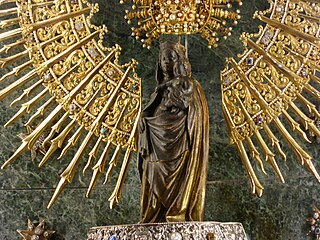
Our Lady of the Pillar is the name given to the Blessed Virgin Mary in the context of the traditional belief that Mary, while living in Jerusalem, supernaturally appeared to the Apostle James the Greater in AD 40 while he was preaching in what is now Spain. Those who adhere to this belief consider this appearance to be the only recorded instance of Mary exhibiting the mystical phenomenon of bilocation. Among Catholics, it is also considered the first Marian apparition, and unique because it happened while Mary was still living on Earth.

The Cathedral of Saint Mary the Royal of the Almudena, commonly known as the Almudena Cathedral for short, is a Roman Catholic cathedral in Madrid, the capital city of Spain. It is the seat of the Archdiocese of Madrid. A fairly young cathedral by Spanish standards, its construction began in 1883 and finished over a century later, when it was consecrated by Pope John Paul II in 1993.
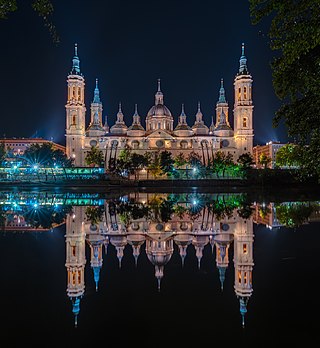
The Cathedral-Basilica of Our Lady of the Pillar is a Catholic church in the city of Zaragoza, Aragon (Spain). The basilica's titular is the Blessed Virgin Mary under the title of Our Lady of the Pillar, praised as "Mother of the Hispanic Peoples" by Pope John Paul II. It is reputed to be the first church dedicated to Mary in history.

Our Lady of Mantara is a Melkite Greek Catholic Marian shrine in Maghdouché, Lebanon, discovered on 8 September 1721 by a young shepherd. The grotto, which according to a legend dates to ancient times, was subsequently cared after by Monsignor Eftemios Saïfi, Melkite Catholic bishop of the Melkite Greek Catholic Archeparchy of Sidon. The shrine consists of a tower crowned with the statue of the Virgin and Child, a cathedral, a cemetery and a sacred cave believed to be the one where the Virgin Mary rested while she waited for Jesus while he was in Tyre and Sidon.. Since its discovery, it has been steadily visited by families particularly each year on the occasion of the feast of the Nativity of Mary on 8 September.
Laguna de Duero is a municipality located in the province of Valladolid, Castile and León, Spain. According to the 2016 census (INE), the municipality has a population of 22 ,696 inhabitants.

Christianity has a strong tradition of pilgrimages, both to sites relevant to the New Testament narrative and to sites associated with later saints or miracles.
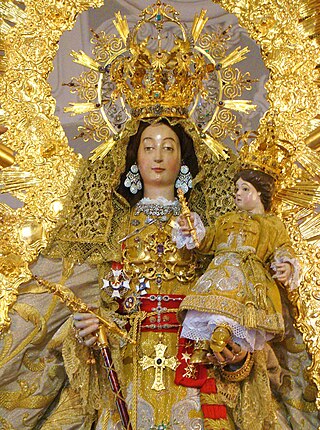
The Virgin of Los Remedios or Our Lady of Los Remedios is a title of the Virgin Mary developed by the Trinitarian Order, founded in the late 12th century. The devotion became tied to the Reconquista of Spain, then still at its height. In the following century it spread to other parts of Europe. When Spain began the exploration and conquest of the Americas, it was a favorite devotion of the Spanish conquistadores. It remains a popular devotion in Spain and Latin America.

The Virgin of Candelaria or Our Lady of Candle (Tagalog: Mahal na Birhen ng Candelaria, popularly called La Morenita, celebrates the Virgin Mary on the island of Tenerife, one of the Canary Islands. The center of worship is located in the city of Candelaria in Tenerife. She is depicted as a Black Madonna. The "Royal Basilica Marian Shrine of Our Lady of Candelaria" is considered the main church dedicated to the Virgin Mary in the Canary Islands and she is the patroness saint of the Canary Islands. Her feast is celebrated on February 2 and August 15, the patronal feast of the Canary Islands.

The Basilica of the Royal Marian Shrine of Our Lady of Candelaria is a Roman Catholic minor basilica, the first Marian shrine of the Canary Islands, located in the municipality and city of Candelaria on the island of Tenerife. It is located some 20 km (12 mi) south of the island's capital, Santa Cruz de Tenerife.

The Cathedral of San Cristóbal de La Laguna or Catedral de Nuestra Señora de los Remedios is a Roman Catholic church in Tenerife, Spain. Begun in 1904 and completed in 1915, it is dedicated to the Virgin of Los Remedios. The cathedral is the mother church of the diocese, which includes the islands of Tenerife, La Palma, La Gomera and El Hierro in the province of Santa Cruz de Tenerife. It is therefore where the episcopal seat of the bishop of this diocese, currently occupied by Bishop Bernardo Álvarez Afonso. This is one of the most important churches of the Canary Islands.

Our Lady of Europe is a title given to the Blessed Virgin Mary as patroness of Gibraltar and protectress of Europe. The entire European continent was consecrated under the protection of Our Lady of Europe in the early 14th century from the Shrine in Gibraltar where devotion continues to this day, over 700 years on.

Our Lady of Peñafrancia is an image of the Blessed Virgin Mary in the Philippines. The Marian image is permanently enshrined in the Minor Basilica of Our Lady of Peñafrancia in Naga, Camarines Sur.
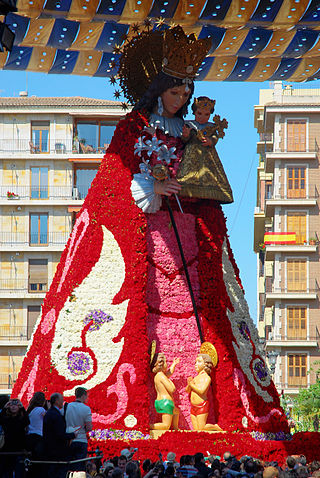
Our Lady of the Forsaken is a Catholic invocation of the Virgin Mary. She is the patroness of Valencia and one of seven patrons of the Autonomous communities of Spain. She appears with a lily in one hand and in the other, she carries the baby Jesus who bears the cross in his arms. Her posture is characterized by a slight forward tilt, and hence, she is known affectionately as the Geperudeta (hunchback) of Valencia. Her image is housed in the 'Basilica de la Virgen de los Desamparados'.

Our Lady of the Most Holy Rosary, Queen of the Caracol, known locally as Mahal na Birhen ng Santo Rosaryo, Reyna ng Karakol or Nuestra Señora Virgen del Santissimo Rosario, Reina de Caracol, is the patroness of the Municipality of Rosario, formerly known as Salinas, in Cavite province, Philippines.

Our Lady of the Most Holy Rosary – La Naval de Manila is a venerated title of the Blessed Virgin Mary associated with the same image in the Philippines. Pious believers believe that the Virgin's intercession under this title helped to defeat the invading forces of the Protestant Dutch Republic during the Battles of La Naval de Manila in 1646.
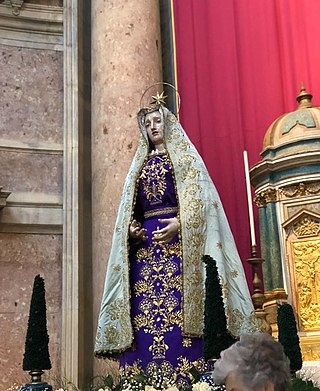
Our Lady of Solitude is a title of Mary, mother of Jesus and a special form of Marian devotion practised in Spanish-speaking countries to commemorate the solitude of Mary on Holy Saturday. Variant names include Nuestra Señora de la Soledad, Maria Santisima, Nuestra Señora Dolorosisima de la Soledad, and Virgen de la Soledad.

The Friday of Sorrows is a solemn pious remembrance of the sorrowful Blessed Virgin Mary on the Friday before Palm Sunday held in the fifth week of Lent. In the Anglican Ordinariate's Divine Worship: The Missal it is called Saint Mary in Passiontide and sometimes it is traditionally known as Our Lady in Passiontide.
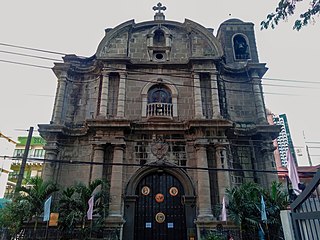
The San Pedro Macati Church, also known as Saints Peter and Paul Parish, or Makati Church is a Roman Catholic church located in Makati Poblacion, the oldest part of Makati and for that reason, the cultural and heritage barangay of Makati, Philippines. In front of the church facade is Plaza Cristo Rey, which was formerly the San Pedro de Macati Cemetery. The Poblacion Church is a government-recognized cultural property based on the official list provided by the National Historical Commission of the Philippines. After 394 years, the church was re-dedicated; the first dedication happened in 1620 when it became a parish church, the next after the reconstruction of the facade in 1796 and finally again, on January 30, 2015. The dedication was led by Cardinal Luis Antonio Tagle, Archbishop of Manila, con-celebrated by Pedro Gerardo O. Santos, the then-parish priest, bishops, and priests.




















